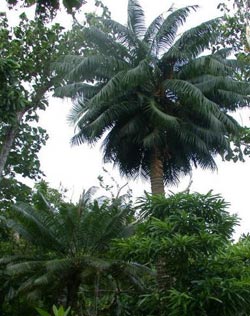Trees' diminished resistance to tropical cyclone winds attributed to insect invasions

The 300+ species of cycads comprise the most threatened group of plants studied to date. Guam's Cycas micronesica is being endangered by recent alien insect invasions.<br><br>Credit: Photo by Thomas Marler<br>
Guam experiences more tropical cyclones than any other state or territory in the United States. These cyclones–called typhoons in the western Pacific Ocean–can be devastating to Guam's dense native forests.
The impact of large-scale tropical cyclones affects the health of managed and unmanaged forests, urban landscapes, and perennial horticulture plantings for many years after the actual storm. In fact, the island's forests are often called 'typhoon forests' because their health and appearance is inextricably defined by the most recent typhoons.
As recently as 2002, Cycas micronesica was the most abundant tree species in Guam. The species is recognized for its innate ability to recover from damage after a tropical cyclone. Resprouting on snapped tree trunks, or “direct regeneration”, enabled C. micronesica to sustain its status as the most abundant tree in Guam through 2002. Although native tree species like C. micronesica possess traits that enable them to recover from tropical cyclone damage, invasive pests and other environmental challenges are compromising the species' resiliency.
Thomas Marler from the College of Natural and Applied Sciences at the University of Guam, and John Lawrence from the U.S. Department of Agriculture, Natural Resources Conservation Service reported on a large-scale study of Cycas micronesica in HortScience. The team compared the impact of two tropical cyclones–Typhoon Chaba in 2004, and Typhoon Paka in 1997–on the resilience and health of Cycas micronesica. They noticed that the proportion of trees exhibiting “mechanical failure” during Typhoon Chaba–in which peak wind speeds were less than half of those in Typhoon Paka–surpassed the damage documented during the more powerful Typhoon Paka. “We set out to determine how a tropical cyclone with moderate wind speeds could impose greater mechanical damage to a highly resistant tree species than a more powerful event only 7 years earlier,” explained Marler.
Marler and Lawrence discovered that although Typhoon Paka compromised the ability of the C. micronesica canopy to avoid wind drag, it was alien invasions following Typhoon Paka that virtually eliminated C. micronesica's resilience to tropical cyclone damage. The data showed that stem decay caused by earlier damage from a native stem borer reduced the species' tolerance to external forces, resulting in stem failure in Typhoon Chaba. Invasions of two invasive insects (Aulacaspis yasumatsui in 2003 and Chilades pandava in 2005) were found to be responsible for the 100% mortality of the intact portions of the trees' snapped stems during the 5 years after Typhoon Chaba.
“A span of less than one decade allowed two alien invasions to eliminate the incipient resilience of a native tree species to tropical cyclone damage,” the authors wrote. “This study underscores the fact that many years of observations after tropical cyclones are required to accurately determine [trees'] resilience.”
The complete study and abstract are available on the ASHS HortScience electronic journal web site: http://hortsci.ashspublications.org/content/48/10/1224.full
Founded in 1903, the American Society for Horticultural Science (ASHS) is the largest organization dedicated to advancing all facets of horticultural research, education, and application.
Media Contact
More Information:
http://www.ashs.orgAll latest news from the category: Ecology, The Environment and Conservation
This complex theme deals primarily with interactions between organisms and the environmental factors that impact them, but to a greater extent between individual inanimate environmental factors.
innovations-report offers informative reports and articles on topics such as climate protection, landscape conservation, ecological systems, wildlife and nature parks and ecosystem efficiency and balance.
Newest articles

High-energy-density aqueous battery based on halogen multi-electron transfer
Traditional non-aqueous lithium-ion batteries have a high energy density, but their safety is compromised due to the flammable organic electrolytes they utilize. Aqueous batteries use water as the solvent for…

First-ever combined heart pump and pig kidney transplant
…gives new hope to patient with terminal illness. Surgeons at NYU Langone Health performed the first-ever combined mechanical heart pump and gene-edited pig kidney transplant surgery in a 54-year-old woman…

Biophysics: Testing how well biomarkers work
LMU researchers have developed a method to determine how reliably target proteins can be labeled using super-resolution fluorescence microscopy. Modern microscopy techniques make it possible to examine the inner workings…





















